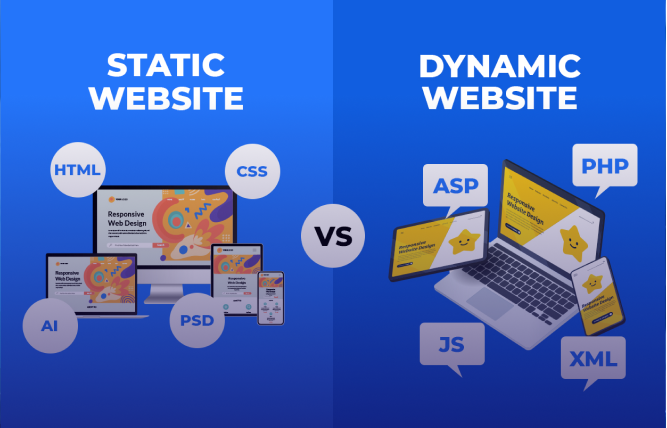Introduction
This blog makes a comparison between front end vs back end development. It delves into the roles, responsibilities, and how both work together to create fully functional websites. We have also mentioned current trends and insights into full-stack development, making it a valuable read for anyone interested in understanding web development better.
Web development can be overwhelming at times, especially when you are caught between front-end and back-end tasks. Although front end and back end have different functionalities, these two areas form the framework on which any site or web-based application stands. So, make it clear: There is nothing like front end vs back end, it’s always a combination of both!
In 2024, the number of websites is expected to exceed 1.13 billion on the World Wide Web. Front-end and back-end development may now seem distinct, yet they are symbiotic. With more emphasis being placed on the internet presence of companies, the need for effective front-end and back-end development remains high.
Recent data shows that the global web development market exhibits a CAGR of 8.5% and is expected to continue growing until 2028. This growth underlines the necessity of modern and feature-rich web development.
Whether you’re a team manager, choosing the next project to launch on or simply interested in the general functionality of the web, it is very important to know the differences between front end vs back end development.
Front End vs Back End: A Detailed Breakdown
To make it easier to understand the jobs of front end vs back end development, let’s compare them. Below is a table that summarises the key aspects of each:
| Aspect | Front End Development | Back End Development |
| Focus | User interface and user experience | Server-side logic, databases, and application functionality |
| Key Technologies | CSS, HTML, JavaScript, Angular, React, Vue.js | Node.js, Python, Java, PHP, Ruby, .NET |
| End-User Interaction | Directly interacts with the user | Operates behind the scenes, invisible to the user |
| Primary Responsibilities | Creating and styling web pages, making them interactive | Managing database operations, server logic, APIs |
| Objective | Create visually appealing and user-friendly interfaces | Ensure smooth data flow and server-side functionality |
| Common Challenges | Browser compatibility, responsive design, load times | Scalability, security, database management |
| End-User Interaction | Directly interacts with the user | Operates behind the scenes, invisible to the user |
| Skillset Requirements | Design sense, creativity, attention to detail | Problem-solving, analytical thinking, server management |
Front End Development: The Role and Responsibilities
Front end development is the core features and functionality that the user sees with and on a website. Consider a house; the front end is similar to the exterior and interior, for example, the walls, the paint, the furnishing and the ornaments that make the house homely. Front end developers ensure that everyone who visits your website finds it pleasing to the eye and easy to navigate.
Key Responsibilities Include:
Building Layouts: Designing data and elements for the website through the hypertext markup language, often abbreviated as HTML. They create elements such as headers, footers, buttons, forms, and more.
Styling: Applying the CSS in order to style the structure of the HTML. This is what gives the website a nice look, as provided by colours, fonts, and creative elements.
Interactivity: JavaScript is the elixir that adds liveliness to your website. It enables functionality like drop-down menus, sliders and modals, and their existence in the public domain cannot be over emphasised.
Cross-Browser Compatibility: Ensuring that the website shows up properly and works correctly in all the current web browsers (for instance, chrome, Firefox, Safari).
Performance Optimisation: Make sure that the website does not take much time to load in order to perform its operations on any given device. To optimise the performance, you should optimise images, make minimum use of HTTP requests, and improve code performance.
Back End Development: The Role and Responsibilities
If the front end is the face of a house, the back end is like its backbone, ensuring the house remains structurally sound and mechanically reliable. As a back-end developer, you are responsible for creating and maintaining the server, database, and application.
Key Responsibilities Include:
Server-Side Logic: Developing the algorithms to give customised functionalities to the website. This includes the development of code for the front end and business logic that deals with the database.
Database Management: Dealing with the storage, retrieval and management of data, all comes under database management. You will use databases such as MYSQL, MongoDB, and PostgreSQL or offer proper storage for data where it can be easily retrieved.
APIs (Application Programming Interfaces): Designing subroutine calls to enable various components of the software systems to interface. This can be intranet APIs in your application or calls to external services APIs.
Security: Modifying and patching the website to prevent other possible threats such as SQL injection, cross-site scripting, and other issues. This is because user’s data is sensitive, and it has to be protected at all costs.
Performance Tuning: Ensuring that the website is functional even if it has a large number of visitors at once without slowing down or ‘freezing’ the server. This may include increasing the efficiency of database queries, using caching techniques, and distributing loads on one or several servers.
How Front End and Back End Work Together
While front end and back end development may appear to be two distinct fields, they are intrinsically linked. It is two sides of the same coin–one side is functional, and the other side is all about aesthetics. So rather than seeing the front end vs the back end, understand that the two components are active in creating a positive web experience. When both the front-end and back-end developers work in harmony, then only you can expect to see a fully functional website.
The front end involves all the aspects of the application that are discerned by the user such as buttons, menus, images and others.
The back end deals with all the invisible processes of helping to accept requests, handling data and making sure that the system runs effectively. Here’s how they come together:
- Data Flow: For example, if a user is engaging with a website in some manner or form, such as completing a form with information, then the front end captures the data and passes it to the back end. The back end processes this data and communicates with the database, then sends the response back to the front end. The subject of this discourse ends with a response being rendered to the user of the software, system or application in question.
- User Experience: Front end vs back end are two ends of an application that must work hand in hand in order to create good and fluid interaction. If the back end is very slow, it means that the user may or may not see that the page has loaded. If the front end is unattractive, the user might get annoyed and leave the website. Therefore, both are equally important in web development.
- APIs and Integration: APIs for short Application Programming Interfaces are the usual ways which the front end and back end have to communicate. They enable the front end to demand some information from the back end and present it to the user. APIs also allow the connection to third-party services as it enhances the capabilities of the website.
In other words, the front end is like the tip of an iceberg—it’s what users see and interact with. But just like an iceberg, there’s a lot more beneath the surface. Without the strong foundation of the back end, the front end wouldn’t be able to function properly. Building a website that works well and is easy to use requires everyone on the team to put aside front end vs back end and work together towards shared goals.
Full-Stack Development: The Fusion of Front End and Back End Development
Even though front end and back end development are considered as two very distinct disciplines, there has been an emergence of full stack developers that encompass both. Full-stack developers are all-rounders who can do everything but, at the same time, understand all the subtleties of the project.
A full-stack developer has the skills to:
- Design and Build Interfaces: Just like a front end developer, a full-stack developer can create the user interface, ensuring it’s attractive and easy to navigate.
- Manage Servers and Databases: On the back end, they can write server-side code, manage databases, and ensure that everything runs smoothly behind the scenes.
- Work Across the Stack: Full-stack developers can switch between front end and back end tasks as needed, providing flexibility and efficiency to development projects.
That is why full-stack developers are a good choice in small teams or in the case of small projects where there is a lack of a proper team. However, hiring full-stack developers is pointless if you desire to build a customised website. You need only professionals who can work on their specific skills and produce quality results.
Top Trends in Front End vs Back End Development
Web development is always evolving, and staying ahead of the trends requires you to follow CI/CD principles. Here are some of the top trends in both front end and back end development that are shaping the future:
Front End Trends
- Frameworks and Libraries: Frameworks such as React, Angular, Vue. js remain rooted, providing developers with rich means to construct engaging application UIs.
- Web Components: These elements are gaining more attention from developers, making it easier to create functional components that can be used in other projects.
- Progressive Web Apps (PWAs): PWAs appear and feel like native apps and they are accessed through the web browser so that they are versatile across devices.
Back End Trends
- Serverless Architecture: It helps developers to develop and host applications without having to worry about servers, leading to cost savings and increased scalability.
- Microservices: It lets you break down applications into smaller, separate services and makes it easier to update, scale, and manage larger projects.
- GraphQL: This API query language is gaining popularity as a replacement for REST, allowing clients to request only the data they need.
Note: These trends are not going to last longer. As a developer, it’s important to stay flexible and keep learning new tools and practices. Whether you focus on front-end, back-end, or both, follow professionals and be flexible to create efficient web applications.
Conclusion
In web development, it’s important to understand the roles of both front-end and back-end. Though these two areas are different, they are closely linked and must work together to create a complete and efficient website. Whether you’re using front-end techniques to design appealing interfaces or handling back-end processes like data management, both are essential to a website’s success. Over time, trends develop, and changes occur, primarily due to the increasing popularity of full-stack developers. One should continue learning and updating their skills to remain relevant in web development.
Frequently Asked Questions
WordPress involves both front end and back end development, making it ideal for WordPress website development.
Both are essential; the choice depends on whether you prefer working on user interfaces (front end) or server-side logic (back end).
CSS is front end. It styles the visual aspects of a website.
Python is primarily back end, used for server-side tasks and data management.
It depends on your project. Front end is for design and user experience; back end handles data and server logic.
Front end focuses on what users see; back end deals with the behind-the-scenes processes. Both are crucial for custom website solutions.
They work closely to ensure that the user interface and server-side logic function seamlessly together.
Common languages include HTML, CSS, and JavaScript.
Popular languages include PHP, Python, Java, and Ruby.
Have questions or feedback?
Get in touch with us and we‘l get back to you and help as soon as we can!




